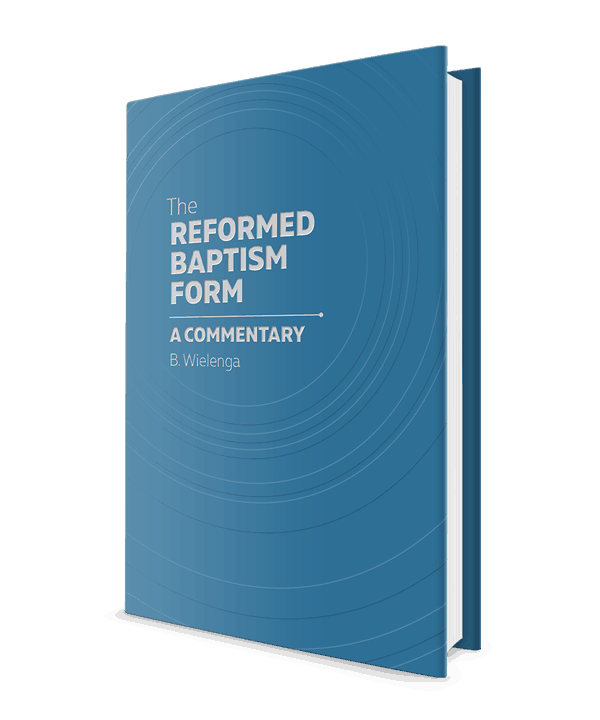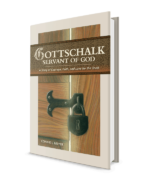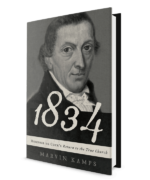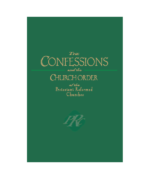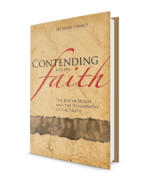Translated into English for the first time is this commentary on the Reformed baptism form by Bastiaan Wielenga, a prominent minister of the Word in the Reformed Churches in the Netherlands (GKN) in the early to mid 1900s. This commentary sets forth, defends and applies the creedal Reformed faith concerning the covenant of grace—the foundation of baptism. This commentary will be especially helpful to Reformed churches, ministers and other members in its explanation of the baptism form’s authoritative treatment of covenant and election in relation to the baptism of infants. The faith of every believer concerning the sacrament of baptism will be expanded and enriched by the commentary.
The Reformed Form for the Administration of Baptism is one of the most important of all the secondary confessions of many Reformed churches worldwide. It is certainly the most read in the churches. In its original form dating from the late 1500s, soon after the Protestant Reformation, it received its present form and official standing from the Synod of Dordt (1618-1619).
In various languages, including the Dutch, the Form functions at the baptism of adult converts and of the infant children of believers in many Reformed churches around the world. By virtue of its use to administer, solemnize and explain the sacrament of baptism, this form is read in the worship services of Reformed churches more often than any other creed or form, with the exception of the Heidelberg Catechism.
Lacking has been a thorough, faithful, sound commentary on the Baptism Form in the English language. This need is now met by a translation into English for the first time of the authoritative, if not definitive, commentary on the form by the highly qualified and esteemed Dutch pastor and theologian, Dr. B. Wielenga, Ons Doopsformulier (in the English translation of the commentary, The Reformed Baptism Form: A Commentary). Kok of Kampen published Wielenga’s commentary in 1906.
The 448-page commentary includes chapters on “The Doctrine of Baptism in General,” “The Doctrine of Infant Baptism in Particular,” “The Prayer before Baptism,” “Admonition to the Parents” and the “Thanksgiving after Baptism.”
The commentary sets forth the Reformed doctrine of baptism as sign and seal, the doctrine of the covenant of God with the children of believers, and other vitally important truths related to the sacrament, including the relation of the covenant and election.
This book is also intensely practical, considering such matters as whether the officiating minister should sprinkle once or three times; whether it is proper to make of the administration of the sacrament an occasion for the gathering of relatives and friends; and, most significantly, whether parents and church are to regard and rear the baptized children of believers as regenerated, saved children of God—according to the judgment of charity in light of the covenant promise to believers and their seed, which is governed by Jehovah’s sovereign election (Rom. 9:6-13)—or as unsaved “little vipers”—in which (latter) case, of course, no rearing is possible.
The author was determined to explain the language itself of the Form, avoiding the temptation to introduce convictions of his own. Written clearly and simply so as to be of benefit to all Reformed believers, the commentary also gives the Reformed pastor deep insight into the sacrament of baptism and its administration. This is a book that will help all Reformed Christians, ministers and churches to be Reformed in thinking and practice with regard to the sacrament of baptism, especially with regard to the baptism of the infant children of believing parents.
From the author’s preface: “The ardent desire of my heart is that by the publication of this writing many people reading this work learn to regard baptism more purely, appreciate it more warmly, and more zealously plead the covenantal promises on behalf of believers and their children, before the throne of him who calls himself I Am That I Am” (p. xvii).
“A WORD ABOUT THE TRANSLATOR. The translator of this work was aptly named. She was Annemie Godbehere. A lovely, godly woman, she was ruled by God. Living with her husband in France, where true, Reformed churches are few and far between, Mrs. Godbehere came into contact with the Protestant Reformed Churches and the Reformed Free Publishing Association (RFPA) through the Reformed conferences in Great Britain of the British Reformed Fellowship. Fluent in Dutch as in French and English, Annemie was engaged by the RFPA to translate certain Dutch works that the RFPA thought profitable for Reformed readers who can read only English. Annemie did not live to see her translation of this work in print. Scarcely had she finished translating this work than she died of cancer. In fact, the cancer made it difficult for her to complete the translation of this work. Heroically, she labored on, in severe pain and despite the hindrance of the medical treatments. If the RFPA dedicated its volumes, this one would surely be dedicated to the memory—the fond memory—of Annemie Godbehere. — David Engelsma, editor” (p. xiii).
An excerpt of this book has been translated into Hungarian.
The Reformed Baptism Form: A Commentary, by B. Wielenga (Edited by David J. Engelsma and translated by Annemie Godbehere). Jenison, MI: RFPA 2016. 448 pages. $39.95 Hardcover. [Reviewed by Rev. Martyn McGeown]
The publication of this book will interest—and even excite—all those who love baptism, and in particular, all those who love the Form for the Administration of Baptism used in Reformed churches. Many church members and office-bearers have heard the Form read, or have used the Form, hundreds of times as baptism has been administered to the covenant seed. But have we sufficiently pondered the beautiful language of the Form?
Bastiaan Wielenga (1873-1949) was a Dutch Reformed minister who not only studied the Form, but who loved the Form, and delighted in its clear, Reformed, biblical, devotional, and pastoral language. He wrote the commentary on the Form not for scholars, but for the ordinary child of God who loves the covenant and the God of the covenant. The RFPA has done the Reformed church world a great service by offering this book—the first English translation of a commentary on this priceless liturgical form—to the reading public.
Wielenga carefully explains (even exegetes) the language of the Form, dividing his material according to the divisions of the Form itself, the doctrinal section (misery, deliverance, and gratitude), a defence of infant baptism, the prayer before baptism, the questions to the parents, and the prayer of thanksgiving after baptism. However, he does not treat the section on the baptism of adults, which, although used on the mission field, is used less frequently in the established church.
Some of the outstanding features of the commentary are the following.
First, Wielenga’s writing is devotional. Wielenga is a very capable theologian and exegetes with the heart and language of a pastor, and even of a poet. The beautiful and moving passages in Wielenga’s writings are so numerous that a reviewer could not possibly do justice to them. Credit for this, of course, must also go to the translator, Mrs. Annemie Godbehere, with whom the reviewer was personally acquainted. Undoubtedly, it was her skill that helped bring Wielenga to life for an English readership. One example of Wielenga’s beautiful turns of phrase will suffice. In this quotation, Wielenga is explaining the need believers have for assurance and the richness of God’s supply in holy baptism:
Do we still need another seal? Does this confirmation need to be confirmed again? The seal sealed?
Yes, it must—because the Lord knows his people. He knows how they lack courage and how feeble they are. He knows that man, because he is in his own existence deceitful, distrusts and disbelieves others, even God.
Hence the Lord God, if he will ever see the mansions filled in his paternal home, cannot be stingy with promises, oaths, and seals. An overflowing source of assurances must let its streams of grace overflow the weak believer. Indeed, our covenantal God repeats his manifold declarations so many times that man, if he were less pathetic, with a dark purple blush of shame about his obstinacy would call out, “Lord, I do believe you; yes, Lord, it is enough, I know it already.”
Because it is exactly the opposite, and the godly constantly ask for stronger assurance, the cry of “Help thou mine unbelief!” does not grow silent before death closes their lips. Thereby God, who takes more pity on us than an earthly father, seals the covenant of grace in baptism. Even with this, he does not account the measure of his undergirding grace full, for in the Lord’s supper he has joined a second and no less royal and divine seal to the covenant (72-73).
Second, Wielenga’s doctrine of the covenant is (mostly) orthodox and mainly in line with our Protestant Reformed understanding. Although he does slip into “agreement” language on occasion, and although he does make a few statements on conditionality within the covenant with which we strongly disagree, Wielenga does view the covenant as an intimate relationship between God and his elect people. “That the Father establishes a covenant with us and adopts us as his children is intimate. That Christ makes us members of his spiritual body is even more intimate. But that the Spirit comes to dwell in us is the most intimate conceivable intimacy” (103).
But baptism, this holy baptism, is a seal and indubitable testimony that we have an eternal covenant with God. It is a covenant not entered into for a time, but rooted in an eternal election. It is a covenant not established on the proof of and dependent on the goodness of men, but anchored in the mediatorial heart of Christ who paid for all the sins of his people and accomplished all obedience.
Note, this is the power and beauty of Reformed doctrine as it shines brilliantly in our form: salvation not promised conditionally, but absolutely guaranteed! (143).
There are places where Wielenga slips into conditional language, but they do not appear so frequently as to mar the book. The astute reader will take note of them.
Third, Wielenga defends that view of covenant children which regards them as regenerate in infancy, and as partakers of a real, spiritual, and not merely external, holiness. This view does justice to God’s promises, rightly explains the language of the Form, and gives great hope to Reformed parents in the rearing of their children. “Just as the children, included in Adam, their covenantal head, are partakers of an internal depravity, so also are the children, included in Christ, partakers of an internal regeneration and holiness” (155). “The compilers of this form also did not regard the children of the congregation as spiritually dead but as spiritually alive” (220). “We are certain that any view other than that of an internal sanctification is out of place in the baptism form and is also not in keeping with the doctrine of the covenant that predominated in the church of the Reformation” (326).
If this child, shortly after baptism, came to die, the parents, if they have come to understand something of the eternal comfort in life and death, may find in this baptism a ground for the hope that their early-deceased darling entered into glory. If the child grows up, the parents may proceed with the rearing from the supposition, or if this word displeases you, from the hope, the quiet expectation, that the God of the covenant has already laid the new germ of life into the child’s heart (407-408).
Wielenga regards the opposite view as Methodism, a Methodism increasingly common in Reformed circles today:
In contrast to the Methodist, who in the rearing only focuses on conversion, making of Sunday school and Christian education a conversion institute, the Reformed parent, who has learned to live out of the covenant, prayerfully looks to the God of the covenant. He pleads the promises of the covenant for his child so that he increases and grows up in the Lord Jesus Christ (408).
Fourth, Wielenga discusses a good number of practical questions concerning the ceremony itself, and there are times when he is unsparing in his criticism of certain practices that had arisen in the churches of his day: should baptism be delayed until the mother recovers or until relatives from out of town can arrive; who should hold the baby; how many times should the water be applied, once or thrice; and should the minister say “Amen” after the baptism? Although some of these matters are historical curiosities to us, some of them are still serious issues today.
Not out of custom! May this reverberate in our ranks. Let us battle against the great enemy of all spiritual life, called custom; against this large monster, which in its cold embrace spiritually smothers thousands—and by its icy breath spiritually murders thousands (286).
Every young parent—especially the fathers, who seek baptism for their children in the consistory room—would do well to read this book. It would be worthwhile for married couples to read this book as they rear the covenant seed. And it would warm the hearts of all Reformed church members to read this book carefully and devotionally, whether they have children or not, for the doctrine of the covenant and of salvation is the joy of our souls.
Reader, may the fruit of the joint contemplation of our precious baptism form be that the word with which this prayer and thus our entire form concludes may find in all our hearts a warm echo. That is to say, on all these truths, promises, and admonitions, may your whole soul pray and worship. Amen (425).
CONTENTS
Foreword – vii
Biographical Sketch of the Author – xi
A Word about the Translator – xiii
Preface – xv
At the Second Printing – xix
Chapter One: Nature and History of the Reformed Baptism Form – 1
Chapter Two: The Doctrine of Baptism in General – 21
Chapter Three: The Doctrine of Infant Baptism in Particular – 145
Chapter Four: The Prayer before Baptism – 185
Chapter Five: Admonition to the Parents – 263
Chapter Six: Thanksgiving after Baptism – 385
“Today I received the commentary on the Reformed Baptism form. I have already read parts of it, and I must say that it is excellent and really helpful.” – Norway
“[This book] is not a deep theological treatise. It was written for the people in the pew. Anyone who reads this volume will be greatly benefited.” – Rev. Jerome Julien
“Every young parent … would do well to read this book. It would be worthwhile for married couples to read this book as they rear the covenant seed. And it would warm the hearts of all Reformed church members to read this book carefully and devotionally, whether they have children or not, for the doctrine of the covenant and of salvation is the joy of our souls.”- Rev. Martyn McGeown

